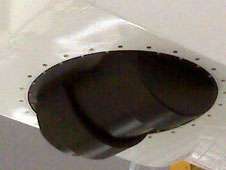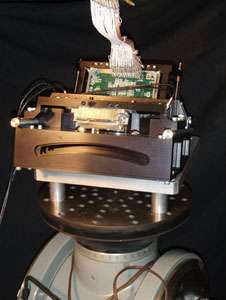New airborne multiangle polarizing imager checked out by NASA ER-2

A team of Jet Propulsion Laboratory researchers and their collaborators at the University of Arizona’s College of Optical Sciences in Tucson are developing a new prototype science instrument for a next-generation space satellite mission that would survey the impacts of aerosols and clouds on global climate change.
The Multiangle SpectroPolarimetric Imager, or MSPI, is a multi-directional, multi-wavelength, high-accuracy polarization camera. It is a candidate instrument for NASA’s Aerosol-Cloud-Ecosystem, or ACE, mission identified by the National Research Council's Earth Sciences Decadal Survey. ACE mission objectives include characterizing the role of aerosols in climate forcing, especially their impact on precipitation and cloud formation.
An airborne prototype version of the instrument, the AirMSPI, was checked out recently on one of NASA's high-altitude ER-2 Earth Resources aircraft during a two-hour flight piloted by NASA Dryden research pilot Tom Ryan from NASA's Dryden Aircraft Operations Facility in Palmdale, Calif. According to JPL's MSPI principal investigator David J. Diner, the maiden checkout flight of the AirMSPI instrument Oct. 7 was very successful. A follow-up checkout flight is slated to occur soon.
The MSPI is a follow-on instrument to the JPL-developed Multi-angle Imaging SpectroRadiometer, or MISR, that is aboard NASA's Terra satellite. An airborne version of that instrument, AirMISR, was previously flown on NASA's ER-2s during missions from Dryden. Some components of AirMISR have been incorporated into the new AirMSPI instrument.

"AirMISR had four spectral bands; AirMSPI has eight, and three of them are polarimetric," Diner explained. "This additional capability will provide greater sensitivity to aerosol optical and microphysical properties.
"The addition of more spectral bands and polarimetry helps pin down the particle properties better," he said. "Intensity and polarization imagery from the checkout flight look very good, so all indications are that the camera is working very well.
"The camera is mounted in a rotating drum which orients it at a pre-programmed set of pointing angles using a motor, and the multi-angular views also help in studying aerosols," Diner said, noting that the AirMSPI can also be used to study clouds and the Earth’s surface.
The novel polarimetric imaging technique used by the AirMSPI was developed by JPL as part of NASA’s Instrument Incubator Program, and the instrument was built under NASA’s Airborne Instrument Technology Transition Program.
Provided by JPL/NASA


















